Original Title: "Special Report on the South Korean Cryptocurrency Market: The Digital Subcontinent Under Kimchi Premium"
Original Author: Klein Labs
TL, DR:
1. Explosive Market Growth
By 2024, the total market capitalization of cryptocurrencies in South Korea surpassed $74.8 billion, with the five major trading platforms managing assets totaling $73 billion. Daily trading volume in December soared to $10.7 billion, surpassing the two major securities trading platforms in South Korea. The unique "kimchi premium" phenomenon (with premiums reaching as high as 10%) reflects the extremely high enthusiasm of local investors.
2. Economic and Social Driving Factors
Limited investment channels: Weak performance in real estate and the stock market has driven funds toward high-volatility cryptocurrency assets.
Korean won depreciation and low interest rates: Expectations of currency depreciation and loose monetary policy have accelerated the allocation of funds to cryptocurrency assets.
Social psychology: Increased wealth anxiety among young people has led to cryptocurrencies being viewed as a "fast track" for social mobility.
3. User and Ecological Characteristics
Universal participation: Approximately 25 million investors (nearly half the population) span all age groups, with a significant proportion of high-net-worth users among the middle-aged and elderly.
Highly concentrated trading platforms: UPbit and Bithumb dominate 98% of the market share, with the local project "kimchi coin" receiving significant attention.
Deep involvement of conglomerates: Giants like Samsung and Kakao are venturing into public chains, trading platforms, and hardware, promoting an ecological closed loop.
4. Future Trends
Favorable policies: New President Lee Jae-myung is promoting cryptocurrency ETFs, Korean won stablecoins, and STO pilots, with tax reforms postponed.
Innovation tracks: DeFi, AI + blockchain, and RWA (real asset tokenization) are becoming key development directions.
Global implications: The South Korean model balances compliance and innovation, potentially serving as a benchmark case for Asia's cryptocurrency hub.
The prosperity of the South Korean market is essentially the result of the interplay between economic structure, social sentiment, and policy direction, providing a unique model of "high activity + strong localization" for the global cryptocurrency ecosystem.
1. Introduction
As the global cryptocurrency market stabilizes, South Korea continues to showcase an "alternative prosperity" characterized by active trading and heightened enthusiasm.
According to the "Annual Payment Settlement Report" released by the Bank of Korea on April 21, by the end of 2024, the total market capitalization of the South Korean market is expected to exceed 100 trillion won (approximately $74.8 billion), with the five major local trading platforms managing a total of $73 billion in assets; the daily trading volume in December surged from $2.38 billion in October to $10.7 billion, surpassing the two major securities trading platforms in South Korea within just two months. The annual revenue of the South Korean cryptocurrency market is projected to grow from $264.3 million in 2024 to $635.4 million in 2030, with a compound annual growth rate of 16.1%. As of April 2025, it has been confirmed that 25 million people have opened accounts on virtual asset trading platforms to invest in cryptocurrencies. Approximately half of South Korea's 51 million population has invested in the cryptocurrency market. Even more noteworthy is the unique "kimchi premium" phenomenon in the South Korean cryptocurrency market, which refers to the prices of cryptocurrencies (such as Bitcoin and Ethereum) on South Korean trading platforms being significantly higher than those on other major global trading platforms. In March 2024, this premium reached 8.5%, peaking at 10% in November, far exceeding the global average, reflecting the high enthusiasm of local investors and the arbitrage demand under capital controls.
The massive flow of funds, broad user base, and unique market price differential effects have collectively shaped the high activity and extraordinary enthusiasm of the South Korean cryptocurrency market, making it a "golden land" in the digital age on the global cryptocurrency map. What has driven the rapid explosion of the South Korean cryptocurrency market? We will analyze the deep logic behind this digital hotbed from three dimensions—driving factors, current situation, and future opportunities: How do political and economic structures generate strong demand for hedging and speculation? How has the local ecosystem evolved from "kimchi premium" to daily trading volumes of $10 billion, creating global-leading trading vitality? Looking to the future, what tracks and innovations will continue to propel the South Korean market forward?
Next, let us delve into this phenomenal prosperity.
2. Analysis of the Reasons for the Hot South Korean Cryptocurrency Market
2.1 Economic Reasons
Limited Investment Channels
Traditional investment channels in South Korea are relatively limited. Under the consumer choice theory framework, individuals weigh utility among different asset classes when faced with limited resource allocation to maximize expected returns. When traditional investment products such as real estate and stocks face high prices, declining returns, poor liquidity, and high entry barriers, investors naturally tend to seek alternative assets with higher marginal utility.
In South Korea, traditional investment channels are facing structural challenges. For example, in real estate and stocks:
- Real Estate:
In 2023, South Korea's economic growth rate was only 1.4%. Although it is expected to rebound to 2% in 2024, consumer and investment confidence remains weak. Against this backdrop, housing prices remain high, presenting structural contradictions. Since 2010, the capital region has increased by 47.1%, and the five major metropolitan cities have seen a rise of 76.5%. In 2024, transaction volume in the capital region decreased by 7.5% year-on-year, with Seoul experiencing three consecutive months of decline from August to October (20.1%, 34.9%, 19.2%).
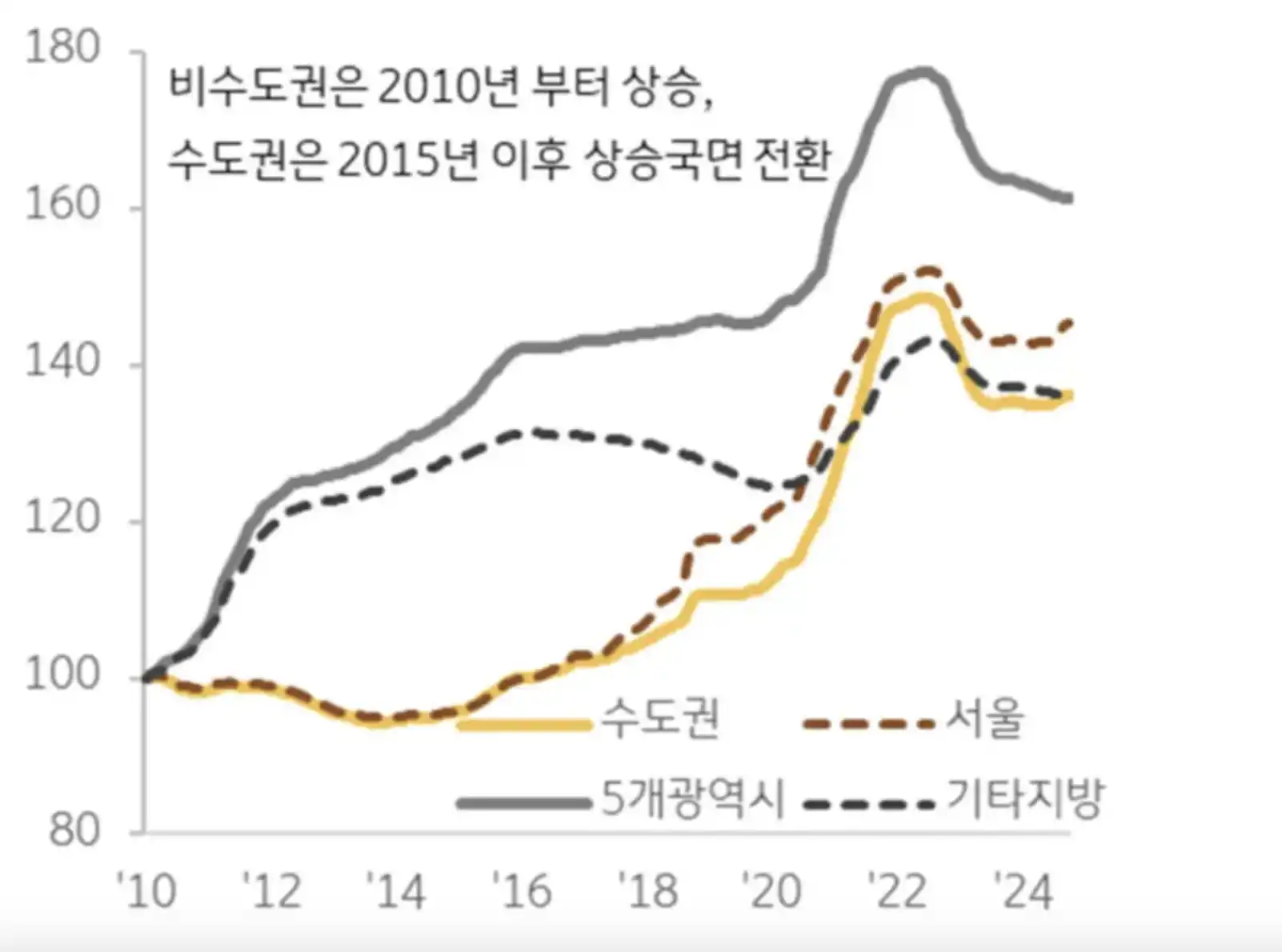
Housing Sales Price Index Trends 2010-2024 (source: KB Think)
Faced with the "three highs and one low" situation of high housing prices, high loan rates, high interest rates, and low transaction volumes, traditional real estate no longer possesses broadly adaptable investment attributes, leading to a noticeable decline in market participation enthusiasm. Young people and low-to-middle-income earners are restricted from purchasing homes, prompting them to turn to emerging investment channels such as cryptocurrency assets, which offer high volatility and high return expectations.
- Stocks
In the stock market, the KOSPI (Korea Composite Stock Price Index) fell by 8.03% in 2024, far below the Shanghai Composite Index's +12.68% and the Nikkei 225's +17.06% during the same period. Meanwhile, the S&P 500 rose, widening the gap in returns between the two markets and the South Korean market to 32.3%, the highest since 2000. While global stock markets generally warmed, the South Korean market exhibited a "lonely downturn" (고립된 약세). Investor confidence was significantly undermined. In the context of the continued poor performance of the traditional stock market and weak return expectations, some South Korean investors began to shift their focus to the cryptocurrency sector, which offers higher volatility and greater return potential.
Low Interest Rates and Loose Monetary Environment
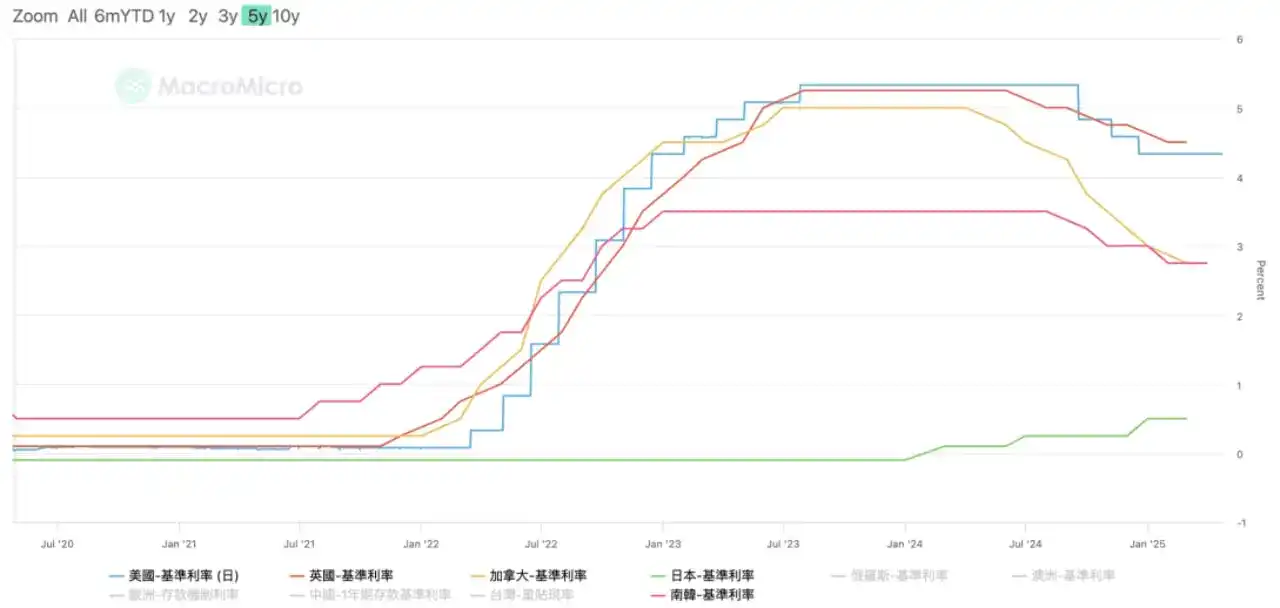
Interest Rates by Country (source: MacroMicro)
Long-term loose monetary policy and a low interest rate environment have prompted South Korean investors to accelerate their shift toward high-yield assets. Since the pandemic, the Bank of Korea's benchmark interest rate has remained at 3.5%, significantly lower than the Federal Reserve's rate of over 5%, leading to a decline in the attractiveness of savings and making it difficult for real returns to withstand inflationary pressures.
In this context, the demand for high-volatility, high-return assets has increased. Cryptocurrencies, with their strong return potential, low entry barriers, and high liquidity, have become the preferred investment direction for risk-seeking investors, especially among the younger demographic. Overall, the low interest rate policy has weakened the attractiveness of traditional financial instruments while further driving funds toward cryptocurrency assets.
Expectations of Korean Won Depreciation
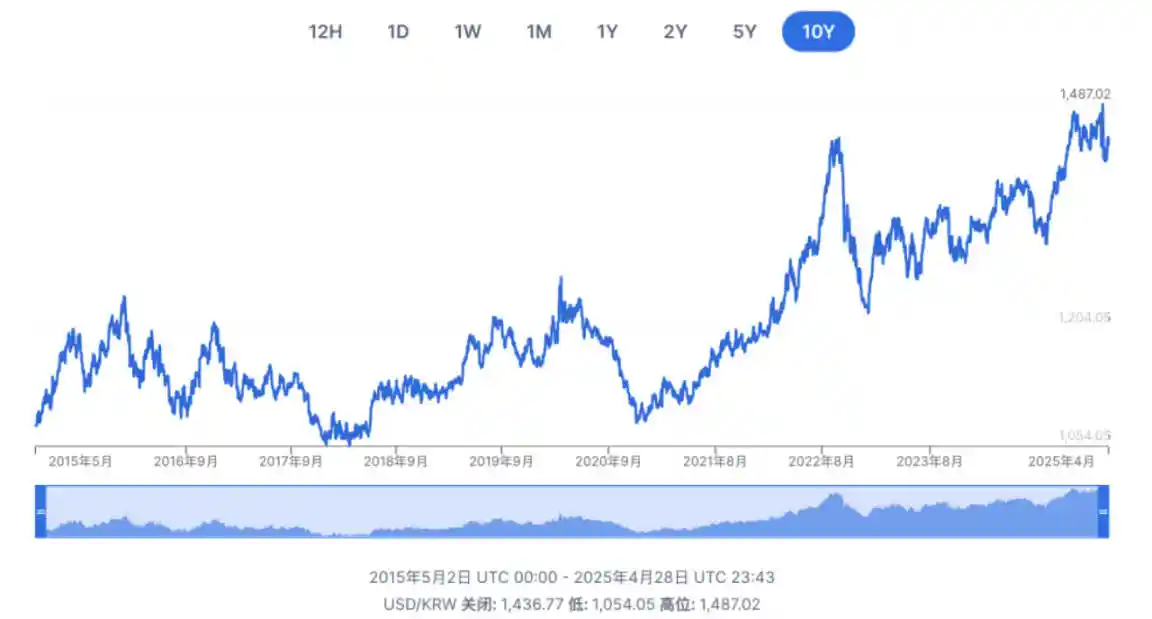
USD to KRW Chart (source: Xe)
In recent years, the Korean won has continued to depreciate, with the exchange rate against the dollar dropping to 1473.75 won in April 2025, the lowest level since 2009. The depreciation of the won, combined with high oil prices and rising supply chain costs, has increased domestic inflationary pressures. Data shows that in March 2025, South Korea's CPI rose by 2.1% year-on-year, with prices for kimchi and coffee increasing by 15.3% and 8.3%, respectively, eroding residents' real purchasing power and putting pressure on economic recovery. As a dollar-denominated, globally circulating, and decentralized asset, cryptocurrency has become a new path for investors to hedge against currency depreciation and pursue asset preservation.
2.2 Social Psychological Reasons
According to economist Paul Samuelson's theory of "Happiness = Utility / Desire," when desires rise rapidly while utility acquisition is limited, individual happiness will significantly decline.
Long-term social class solidification, high competitive pressure, and economic fluctuations have intensified wealth anxiety among young people, making "money" a dominant life goal. Data from the Bank of Korea in 2024 shows that 72.4% of respondents believe that "economic conditions" are the primary determinant of happiness. Meanwhile, a report from the Korean Statistical Office in early 2025 indicated that 69.1% of individuals aged 20-39 listed "financial freedom" as their primary life goal. In this social sentiment, slogans like "돈이 최고야 (Money is the most important)" and "현실이 개차반이야 (Reality is terrible)" have become popular. As traditional paths such as employment, savings, and stock market returns fail to meet wealth desires, cryptocurrencies have emerged as a high-utility investment choice for young people seeking to break through class limitations, seen as a potential channel for achieving happiness and reversing their fortunes.
At the same time, around the goal of "financial freedom," the consumption concepts of the young population in South Korea are undergoing profound changes, further influencing their investment preferences. According to reports from media outlets like "Asia Economy," young people in South Korea are exhibiting two typical consumer psychological divergences:
One is the "YOLO (You Only Live Once)" group, emphasizing immediate enjoyment and high-risk preferences; the other is the "YONO (You Only Need One)" group, inclined toward rational consumption and valuing asset accumulation. Among the YOLO group, facing real pressures and class anxieties, many young people tend to view the cryptocurrency market as a "get-rich-quick opportunity" that surpasses the stock market, aiming to break through traditional wealth paths and achieve social mobility. Conversely, the YONO group, considering asset preservation and hedging against economic uncertainties, is gradually shifting toward increasing savings and investments. According to a 2024 survey on Generation Z consumption trends, about 71.7% of young respondents indicated that they would prioritize savings and asset allocation. Cryptocurrencies, due to their high returns, have become a new investment choice.
Despite differing consumption attitudes, both groups converge in their motivation to invest in high-yield assets, and cryptocurrencies perfectly meet their shared psychological pursuit of returns and wealth growth.
2.3 Why is South Korea So Prosperous, and Not Japan?
2.3.1 Economic Perspective: The Relative Weakness of the Korean Won Necessitates Alternative Paths
- Japanese Yen: Due to its extremely low interest rates and large foreign exchange reserves, the yen is internationally regarded as a safe-haven currency. Even when the yen's exchange rate fluctuates, its financing advantages remain unchanged, and the market is more willing to hold yen assets to hedge against declines in other markets during geopolitical risks or financial turmoil.
· Korean Won: The market size is small, liquidity is weak, and it fluctuates in line with global risk sentiment. Additionally, the status of foreign exchange reserves is relatively weak, with some capital controls, making it difficult to assume the same position as the yen.
Therefore, compared to Japanese investors, South Korean investors lack long-term trust and security in domestic currency assets, tending to seek non-local currency-denominated assets that can circulate globally, which aligns well with the demand for cryptocurrencies.
2.3.2 Economic Perspective: Traditional Investment Yields Are Lower, Pursuing Higher Returns
· Real Estate: Investment in South Korean real estate accounts for over 50%, significantly higher than Japan's 37%, but the overall actual yield is lower, and there are more restrictions on real estate investment:
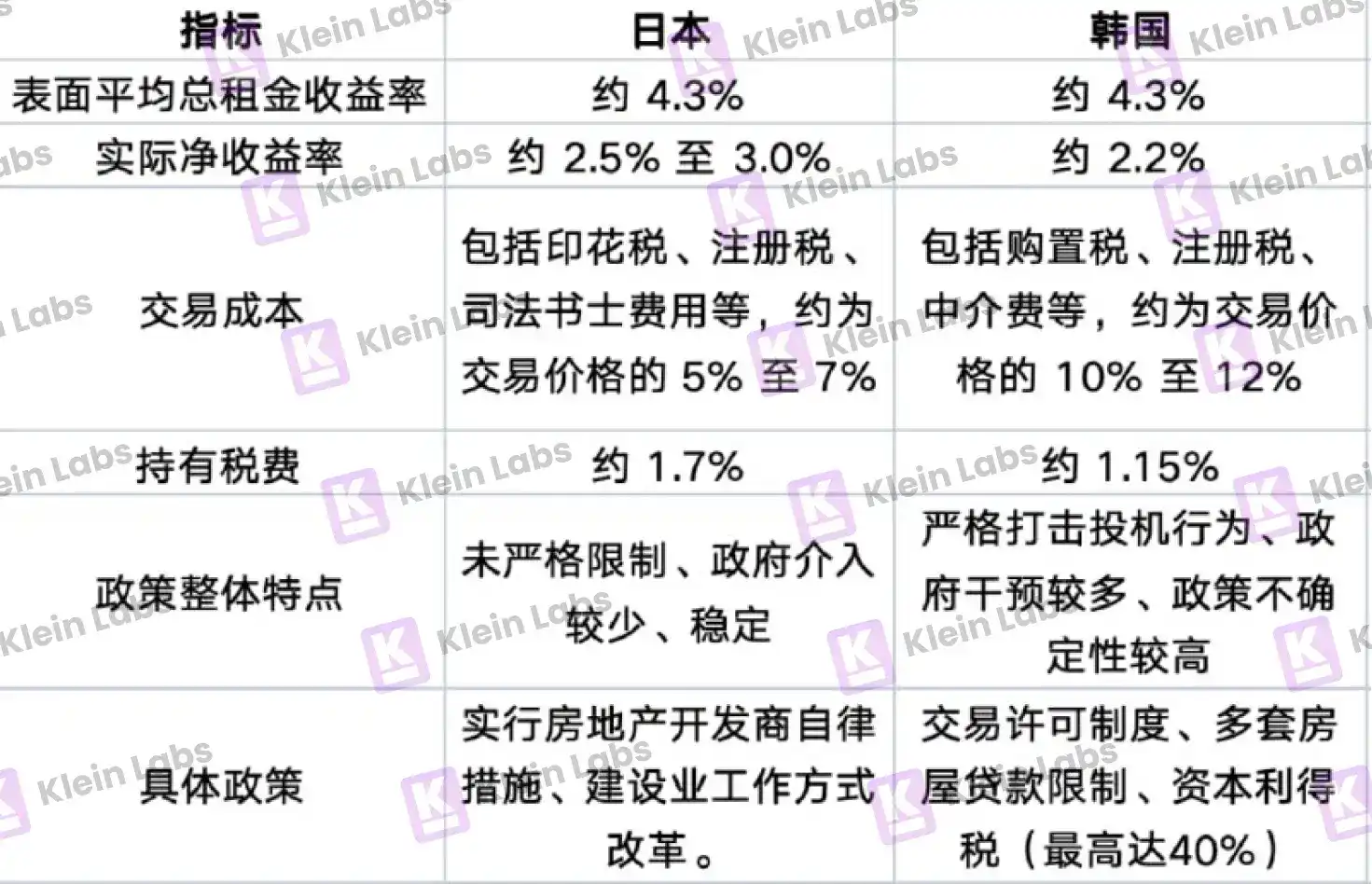
Comparison of Real Estate Yields in Japan and South Korea (source: Klein Labs)
· Stock Market: In recent years, the South Korean stock market has been relatively weak compared to Japan. However, this was particularly evident in 2024:

Comparison of Stock Markets in Japan and South Korea (source: Klein Labs)
2.3.3 Policy Perspective: South Korea's Open Attitude, Japan's Conservative Restrictions
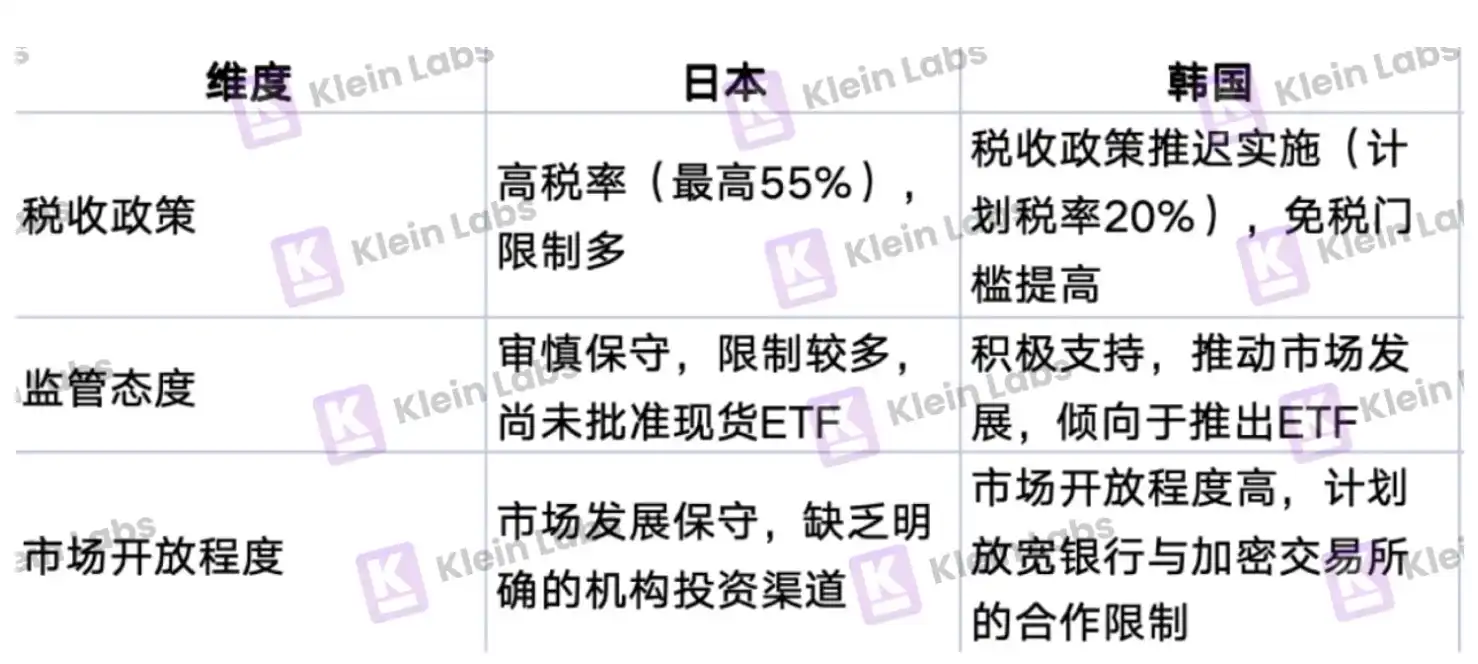
Comparison of Cryptocurrency Policies and Attitudes in Japan and South Korea (source: Klein Labs)
2.3.4 Cultural Perspective: South Korea Pursues Quick Wealth, Japan Emphasizes Steady Accumulation
· Japan: Places greater emphasis on "small savings accumulate to a lot" and "steady financial management." Proverbs like "一生懸命働いて、少しずつ貯める" (Work hard all your life, save little by little) and "家宝は寝て待て" (Treasure waits for itself) reflect the Japanese tendency toward long-term accumulation and steady appreciation, emphasizing values of restraint, accumulation, and patience.
· South Korea: Emphasizes "quick success" and "following trends," with concepts like "빨리빨리 (quickly)" prevalent in society, where people are more inclined to pursue short-term high returns, desiring to achieve quick wealth through stock trading, cryptocurrency speculation, and real estate.
The prosperity of the South Korean cryptocurrency market is essentially the result of investors making optimal trade-offs in macroeconomics, traditional assets, government attitudes, and cultural thinking. Although Japan, as another developed country in East Asia, has a relatively similar foundation, it still falls slightly short compared to South Korea's standout position in the global cryptocurrency market.
2.4 Insights from the South Korean Model for the Global Cryptocurrency Market
As the landscape of the Asian cryptocurrency market quietly changes, South Korea's "middle way" is highlighting its strategic value. Compared to Singapore's recent tightening of regulations on local projects providing services overseas, as well as the slow pace of approvals and taxation in Hong Kong and Japan, South Korea's institutional flexibility, cultural fit, and capital environment are forming a new comparative advantage.
The Monetary Authority of Singapore (MAS) recently required local projects to stop providing token services overseas by the end of June and canceled transitional support, breaking its previous "foreign-friendly" regulatory image. This abrupt policy shift has led many cryptocurrency companies to reassess their deployment in the Asian market, turning their attention to countries with more flexible regulations and greater operational space. While Hong Kong is also actively opening up, its complex regulatory layers and cautious pace make it difficult to accommodate a large number of project transfers in the short term.
In this context, South Korea is becoming a strong candidate in the next round of competition for cryptocurrency hubs in Asia, leveraging its local resource integration capabilities, technological implementation efficiency, and social cultural cohesion. For the global market, the key insight from the South Korean model is that regulation can be encouraging rather than fully relaxed; user education and cultural adaptation are the underlying logic for all growth; and infrastructure sovereignty and international collaboration are not in conflict but are dual drivers of future development.
In the new policy game in Asia, South Korea is not only an active consumer market but also has the potential to become a regional source of technology and a major asset management hub. If the global cryptocurrency industry is to localize and take root, South Korea provides a practical model worth emulating.
3. User Analysis of the South Korean Market
3.1 User Profile of the South Korean Market
Market and Account Types: Overall Rapid Growth
· Growth in Investor Scale: As of January 2025, the five major trading platforms in South Korea (UPbit, Bithumb, Coinone, Korbit, Gopax) had approximately 25.25 million registered individual investors. This represents an increase of about 37.6% compared to the same period three years ago. This growth reflects the rapid expansion of the market, attracting a large number of new user registrations and indicating an accelerated adoption of cryptocurrencies in South Korea, with market penetration gradually increasing.
· Growth in Actual Users: As of February 2025, the total number of accounts on South Korean cryptocurrency trading platforms exceeded 25 million, with approximately 17.09 million accounts being actual active investors. In 2024, as the market heated up, activity levels significantly increased: following Trump's re-election, the number of inactive accounts decreased from about 8.57 million at the beginning of 2024 to 8.01 million by the end of the year, indicating a gradual recovery in investor confidence and a return of funds to the cryptocurrency market.
· Age and Gender: Significant growth among young users, with rising female participation

source: Financial Services Commission of South Korea
Users in the South Korean cryptocurrency market are primarily composed of individuals in their 30s and 40s, accounting for over 50% of the total, indicating that mainstream trading users are concentrated in economically stronger and more mature investment awareness groups. The young user group under 20 years old also shows strong growth momentum, accounting for 18.6%. This data indicates that cryptocurrency assets are rapidly gaining popularity among the younger generation, making young people an emerging force in the market and bringing greater growth potential for the future.
As age increases, the gap between female and male participation in the cryptocurrency market gradually narrows, especially with an increase in participation among middle-aged and elderly women. This indicates that although the market share of young women is low, their participation is significantly increasing among economically stronger middle-aged groups.
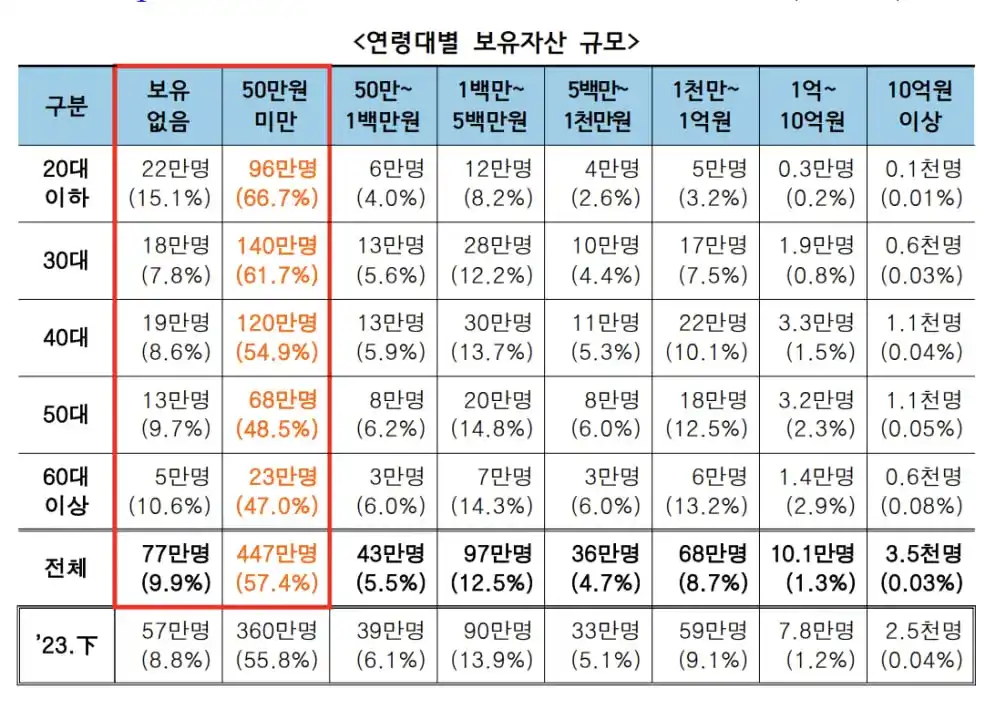
source: Financial Services Commission of South Korea
Age and Capital Scale: Clear Generational Stratification
The South Korean cryptocurrency market is primarily composed of small investors, with most users holding less than 500,000 won, particularly concentrated in the younger demographic. Meanwhile, the proportion of users holding over 10 million won in assets is 10%, slightly down by 0.2 percentage points from the end of 2023, and the number of users holding over 100 million won has decreased to 104,000, reflecting a decline in the proportion of high-net-worth individuals in the market. From the correlation between age and asset scale, younger users tend to prefer small investments (under 500,000 won), while older users (aged 50 and above) are more inclined to make larger investments (over 5 million won), with this high-net-worth group becoming the mainstay of value in the cryptocurrency market. Notably, although the proportion of investors over 60 is small, the total amount of virtual assets they hold reaches 13.3795 trillion won, and they tend to have a relatively conservative investment inclination, managing their retirement funds by investing significant amounts in high-market-cap currencies like Bitcoin.
The South Korean cryptocurrency market exhibits a "dual-layer structure" characteristic—young people primarily contribute to user numbers and activity, while the middle-aged and elderly hold more assets and trading volume. This indicates that the market has a very clear generational stratification in its user composition.
3.2 User Behavior Phenomena
3.2.1 User Asset Preferences
Global Asset Proportion vs. Domestic Asset Proportion: Local Personalization Influence
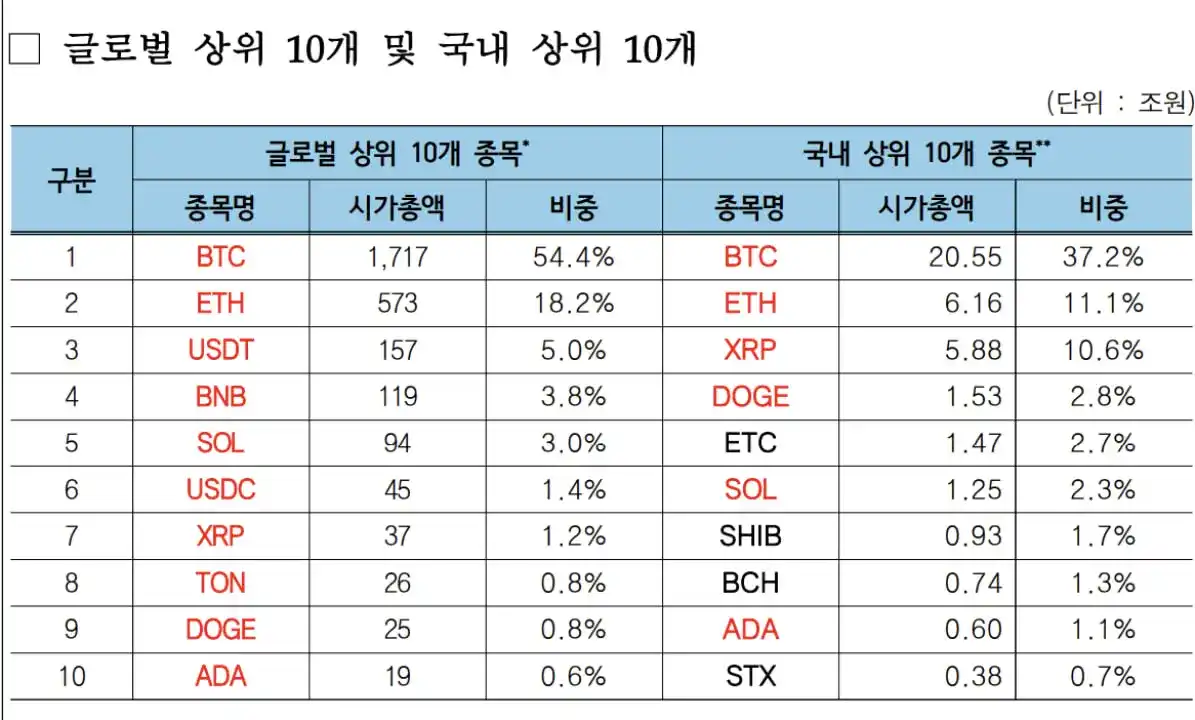
source: Financial Services Commission of South Korea
· Continuous Growth of the South Korean Virtual Asset Market: The domestic virtual asset market in South Korea has reached a market value of $21.2 billion, a 46% increase from last year, indicating rapid market expansion.
· Bitcoin Dominates the Market: Bitcoin remains the dominant asset in the South Korean market, accounting for a total trading volume of 37.2%, far exceeding other assets.
· Strong Appeal of XRP in South Korea: Despite its lower global ranking, XRP has a market value of $588 million in South Korea, ranking second, indicating its high popularity among South Korean users.
· High Concentration of Mainstream Assets: The top ten virtual assets in the South Korean market are largely consistent with the top ten globally, reflecting a preference for mainstream assets (such as ETH, DOGE, SOL) in the South Korean market.
3.2.2 Overall User Behavior Characteristics
In the South Korean cryptocurrency market, user behavior exhibits a highly concentrated characteristic.
Preference for Trading Platforms: According to market data from 2024, the largest cryptocurrency trading platform in South Korea, UPbit, occupies about 70% to 80% of the domestic market share, demonstrating its dominant position in the local market.
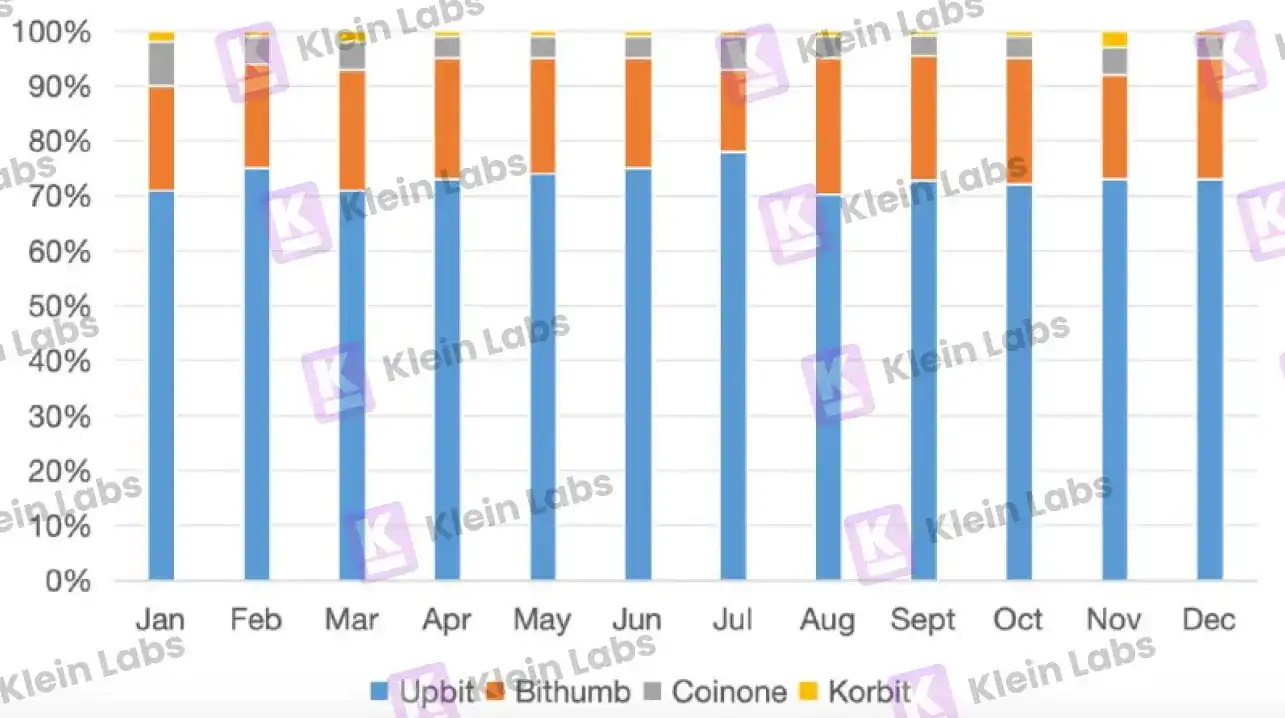
Market Share of the Top Four Trading Platforms in 2024 (source: Klein Labs)
Preference for Trading Configurations: The premium and trust endorsement of local projects drive the flow of funds. Users are more enthusiastic about trading "kimchi coins" (such as Steem Dollars, Moss Coin, Hippocrat) that are exclusively listed on trading platforms, while the trading activity of mainstream assets is relatively lower compared to the global market; local trading platforms further amplify the "kimchi premium" effect through large-scale promotional collaborations, attracting a continuous influx of funds.
3.2.3 On-Chain Usage
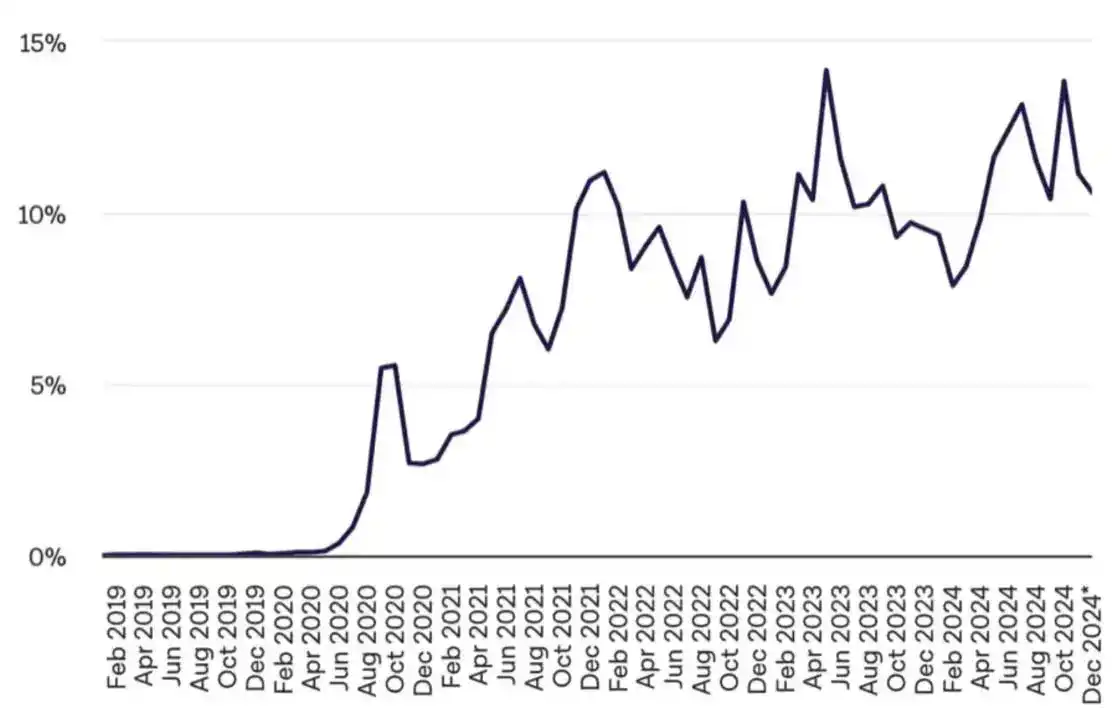
DEX vs. CEX Market Share (source: The Block)
As the global cryptocurrency ecosystem evolves, decentralized exchanges (DEX) are rapidly rising. By December 2024, the global DEX spot trading volume accounted for 13.76% of centralized exchanges (CEX), with a daily trading volume reaching $54.84 billion. In contrast, the South Korean market's reliance on CEX remains significantly higher than the global average. Data shows that approximately 68.9% of trading volume is still concentrated on centralized platforms, with low usage rates for DEX and DeFi protocols, indicating that local users prefer stable and regulated trading environments.
However, South Korea's on-chain ecosystem is awakening quickly. The proportion of DEX trading rose from 8.57% in 2024 to nearly 17%, and by early 2025, DEX trading accounted for 16.7%. Platforms like Raydium and Phantom within the Solana ecosystem are favored by young South Korean users due to their low barriers to entry and quick listing processes. Platforms like Pump.fun have also sparked retail interest in DEX, driving a shift in trading behavior. Despite this strong momentum, the South Korean DeFi market has yet to fully explode due to local regulatory constraints and capital flow restrictions. To realize its potential, a balance between "safety and innovation" must be achieved at the regulatory level to open up growth channels for on-chain finance.
4. Overview of South Korean Cryptocurrency Trading Platforms
Local trading platforms in South Korea exhibit a strong listing effect, particularly mainstream platforms like UPbit, where once a project is listed, it often triggers significant market fluctuations, becoming an important barometer for the cryptocurrency market. This effect has led many projects to view securing a listing on South Korean trading platforms as one of their core objectives when vying for market resources. Additionally, the Korea Blockchain Week (KBW) has become a globally recognized cryptocurrency event, serving as a crucial platform for trading platforms to announce listings, showcase projects, and facilitate capital communication. This year's KBW (X: @kbwofficial) will be held from September 22-28, 2025, organized by FACTBLOCK (X: @FACTBLOCK). Global cryptocurrency practitioners will gather in Seoul during this time.
The South Korean cryptocurrency trading market is highly concentrated, primarily dominated by five major spot trading platforms: UPbit, Bithumb, Coinone, Korbit, and Gopax.
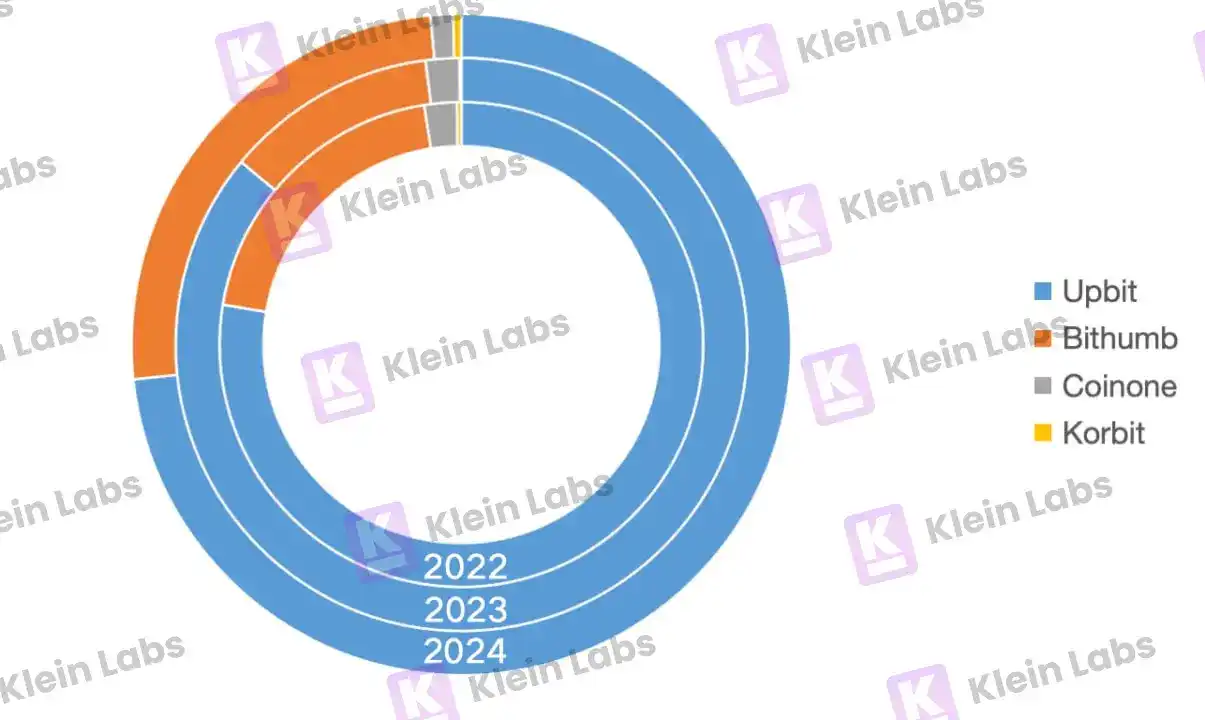
Comparison of Market Shares of the Four Major Local Trading Platforms in South Korea (2022-2024) (source: Klein Labs)
Observing the market shares of the four major South Korean trading platforms over the past three years, we can draw the following preliminary conclusions:
The combined market share of the top two platforms (UPbit and Bithumb) accounts for over 98% of the total market share, indicating a severe monopolistic effect at the top. Despite UPbit adopting the most conservative listing policy, its market share still grew from 78% to 86% last year. Bithumb experienced the largest year-on-year decline in sales, which may be related to its implementation of a zero-commission policy in the fourth quarter of 2023, significantly reducing sales and profits. This policy may have positively impacted user trading activity, narrowing the market share gap between Bithumb and other trading platforms, indicating that this policy played a key role in enhancing the platform's competitiveness. Coinone and Korbit have smaller market shares but can meet niche demands through differentiated strategies, gradually expanding their market share and enhancing competitiveness by leveraging the long-tail effect.
4.1 UPbit
Operated by Dunamu and supported by Kakao, UPbit has a broad user base and high compliance, being one of the first platforms in South Korea to obtain a Virtual Asset Service Provider (VASP) license. Since its establishment in 2017, it has rapidly developed into a market leader, supporting direct KRW deposits, making it highly attractive to local users and ranking among the top five cryptocurrency trading platforms globally. Currently, UPbit offers trading pairs in KRW/Bitcoin/USDT (KRW/BTC/USDT), with most trading volume coming from the KRW market. UPbit boasts ample liquidity and consistently ranks among the top five in spot trading volume in global trading platform competition.
4.2 Bithumb
Founded in 2014, Bithumb was once the leader in the South Korean market and is currently the second-largest liquidity trading platform in South Korea, following UPbit. Bithumb is actively seeking growth and plans to conduct an initial public offering (IPO) in 2025. With an aggressive fee policy, Bithumb has recently regained market share and continues to play an important role.
4.3 Other South Korean Platforms
Coinone is renowned for its high security, having not experienced any security incidents in its eight years since establishment. It was the first trading platform in South Korea to list Ethereum and has been active in the meme token sector. Korbit, the earliest established platform, launched KRW/Bitcoin trading in April 2013, being the only South Korean trading platform to experience the Bitcoin surge at the end of 2013; Korbit YouTube and Korbit Research are also known for providing high-quality information.
4.4 Overseas Trading Platforms in South Korea
In South Korea, overseas trading platforms such as Binance, OKX, KuCoin, Kraken, Bybit, and Coinbase are gradually attracting a large number of investors. Investigations by the South Korean Financial Services Commission into Virtual Asset Service Providers (VASP) show that the transfer of funds to overseas VASP wallets has increased 2.3 times compared to last year. This phenomenon is primarily due to low stock market returns and political instability. Especially after the December 2024 martial law incident in South Korea, service interruptions at major local trading platforms severely undermined trust in their stability, leading more investors to turn to overseas trading platforms and DeFi platforms.
Advantages:
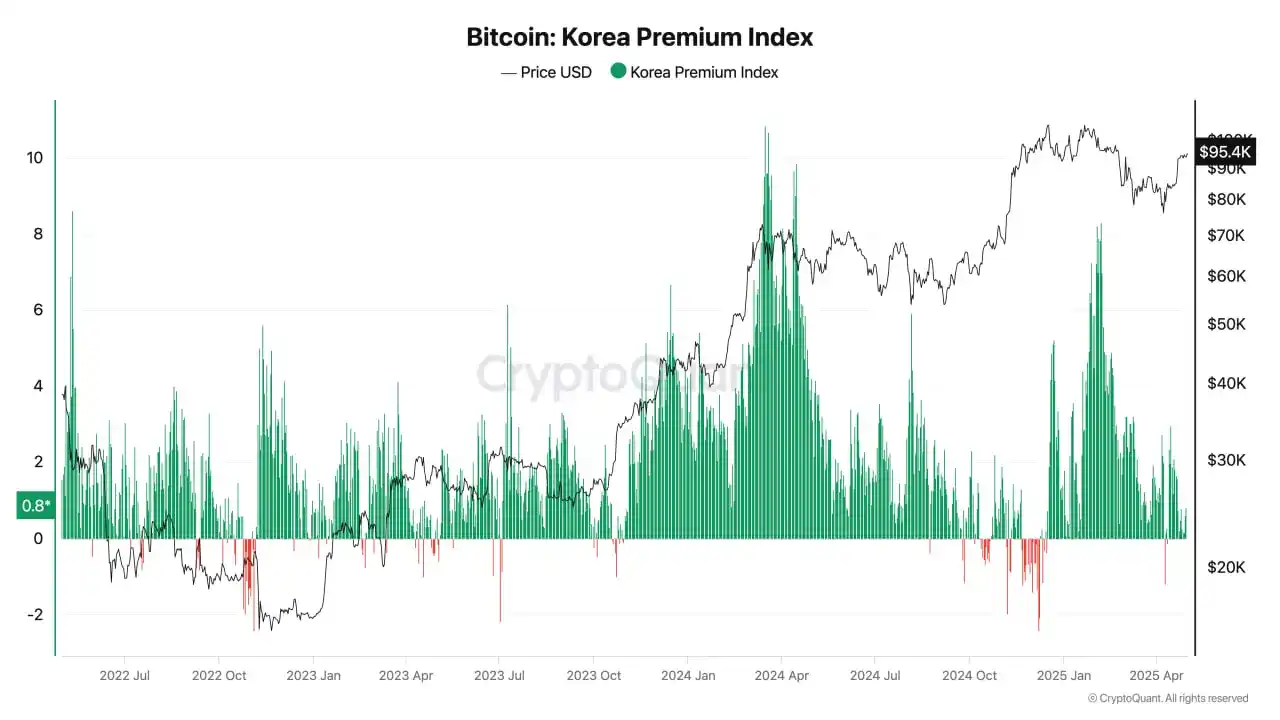
Bitcoin: South Korea Premium Index (source: CryptoQuant)
South Korea Premium Index = (Price on Local Trading Platforms - Global Average Price) ÷ Global Average Price × 100%
The South Korea Premium Index has long been above 0, indicating that the South Korean cryptocurrency market consistently exhibits a premium above the global average, reflecting strong local demand or restricted capital flow.
The main advantage of investing on overseas trading platforms lies in the "kimchi premium," where cryptocurrency prices on South Korean trading platforms are typically higher than those in the global market, with premiums reaching up to 20%. Investors can buy at lower prices overseas and sell domestically at a premium for profit. The revenue of South Korean trading platforms primarily relies on trading commissions, and regulatory restrictions limit their business diversification. Due to the lack of derivative trading features, investors typically choose overseas platforms like Binance and OKX for margin trading to achieve higher returns.
Limitations: Government Measures. The South Korean Financial Intelligence Unit has banned access to 17 unregistered overseas cryptocurrency trading applications, restricting users from downloading and updating them, including KuCoin, MEXC, Phemex, and others.
5. Overview of Investment Institutions and Market Makers in the South Korean Market
South Korean cryptocurrency investment institutions exhibit three main characteristics:
The types of institutions include pure cryptocurrency venture capital (VC), corporate venture capital (CVC), and multi-strategy hedge funds. Investment stages range from seed rounds to growth phases, with industry focuses including DeFi, NFTs, Web3 gaming, infrastructure, and artificial intelligence. There are significant differences among institutions in terms of regional layout, ecosystem development, and project incubation, with successful cases spanning globally recognized protocols and startup projects.
In the South Korean cryptocurrency market, the main investment institutions include:
Hashed
· Introduction: Established in 2017 and headquartered in Seoul, Hashed focuses on early Web3 project incubation in the Asian market, combining capital and ecosystem-building functions, and strengthening community engagement through events like "Hashed Potato Club" and KBW.
· Notable Success Cases: Well-known games and metaverse projects such as Axie Infinity, The Sandbox, and Decentraland.
· (X: @hashed_official)
Nonce Classic
· Introduction: Founded in 2018, it prides itself on being a "social network-driven VC," emphasizing team collaboration and information sharing, providing incubation support for invested projects through community mechanisms.
· Notable Success Cases: Seed round investments in projects like Eisen, Pilgrim Protocol, and Radius, with a focus on Layer 1 and DeFi infrastructure. (X: @nonceclassic)
Blocore
· Introduction: The corporate venture capital arm of Gameberry, focusing on "investment + incubation," specializing in Web3 gaming and IP projects, providing support from seed to growth stages.
· Notable Success Cases: Early investments in leading projects like Animoca Brands, The Sandbox, and Wemix, helping multiple game developers enter the global market. (X: @blocore_vc)
Samsung Next
· Introduction: The innovation investment arm of Samsung Group, covering diverse tracks such as Web3 infrastructure, AI hardware acceleration, security monitoring, and asset management, connecting enterprise-level and consumer-level applications.
· Notable Success Cases: Participated in a $43 million Series A funding round for Sahara AI and invested in international leading projects like Yuga Labs, LayerZero, and Berachain. (X: @SamsungNext)
Tiger Research (타이거 리서치)
· Introduction: Known for on-chain data analysis and quantitative research, it provides precise market-making solutions for DeFi protocols and various trading pairs through its self-developed price discovery algorithms and risk control models. Its exclusive "dynamic order" strategy can automatically adjust order volumes based on market depth and transaction tendencies. The team provides services covering mainstream exchanges like UPbit and Coinone and is deeply involved in local DeFi project testnet incentive programs. (X: @TigerResearch)
Klein Labs(클라인 랩스)
· Introduction: Klein Labs is a research-driven Web3 crypto service provider focused on offering customized liquidity management, full-stack growth solutions, and capital strategies for participants in the crypto ecosystem. Utilizing advanced data analytics and algorithmic strategies to optimize bid-ask spreads, it minimizes trading slippage. Klein Labs not only provides market-making services but also integrates marketing, listing, and fundraising support, offering a one-stop solution for projects in South Korea while also engaging in early-stage venture capital and incubation. (X: @kleinlabsxyz)
6. Star Projects in the South Korean Market
In the South Korean crypto market, a number of protocols are gaining unexpected user recognition and growth momentum due to product fit, community operation, and channel adaptation. Below are some projects and protocols that have performed strongly in the South Korean market, with active community engagement and high trading participation.
6.1 Underlying Ecosystem
6.1.1 Kaia
An Asian Layer 1 co-incubated by Kakao and Naver, focusing on distributed credentials and points systems. It has generated over 38 million wallets, connected to over 80 mini-programs, with daily active addresses reaching 1-1.5 million. (X: @KaiaChain)
6.1.2 Story Protocol
Positioned as a "programmable narrative engine," it supports on-chain creation and licensing of IP, with over 120 DApps launched, partnering with South Korea's three major mainstream media and leading game manufacturers. (X: @StoryProtocol)
6.1.3 Arbitrum
Established a local community "Arbitrum Korea," collaborating with Delabs and Lotte Metaverse; registration increased by 45% in the first month, accounting for 28% of South Korea's L2 trading volume. (X: @arbitrum)
6.1.4 Aptos
Partnered with Supervillain Labs to host hackathons and developer salons in Seoul; promoting Move education, with community DApp monthly active users exceeding 5,000 and a 75% year-on-year increase in developer participation. (X: @Aptos)
6.1.5 Monad
Released Korean documentation and SDK, launched the "Monad Analyst Certification" course in collaboration with the Seoul Digital Asset Research Institute, with the official Discord Korean community surpassing 8,200 members. (X: @monad_xyz)
6.1.6 ICP
ICP has established an official Hub in South Korea, with the ecological project Piggycell connecting to the largest shared charging platform in Korea and being selected for the Olympus Accelerator program. (X: @dfinity)
6.2 DeFi
6.2.1 Mitosis
A modular multi-chain asset management protocol that supports cross-chain lending and strategy configuration. Multiple pools have been launched, with stable trading growth. (X: @MitosisOrg)
6.2.2 Keplr Wallet
A native wallet for Cosmos, highly popular in the South Korean community; formed the "Korea Hub" with local validators, with local staking volume accounting for over 40% of the entire network. (X: @keplrwallet)
6.2.3 Exponents Fi
Focusing on yield automation and risk management, it has dynamic strategy adjustment capabilities. TVL grew by 20% in the first month of launch, gaining popularity among professional users. (X: @Exponents_Fi)
6.2.4 Xangle
A leading on-chain data service and solution provider, helping enterprises thrive in the dynamic web3 environment. (X: @Xangle_official)
6.3 GameFi
6.3.1 MapleStory N / Nexon
Developed by Nexon, "MapleStory N" has become a hit Web3 RPG, with a token $NXPC market cap exceeding $200 million and listed on top trading platforms. (X: @MaplestoryU)
6.3.2 Delabs
A sub-brand of 4:33 Games, the game "Rumble Racing Star" features an on-chain racing asset mechanism; the platform has over 400 million global players, and the game's airdrop activities attract a large number of participants. (X: @DelabsOfficial)
6.3.3 Wemix
One of the strongest blockchain game infrastructures in South Korea, with daily transaction volume reaching $20 million. It supports DeFi/NFT/SoFi and hosts over 100 blockchain games both domestically and internationally. (X: @WemixNetwork)
6.3.4 BigTime
A cross-genre MMORPG that combines elements from World of Warcraft and Diablo, attracting a large group of hardcore action gamers in the South Korean market. (X: @playbigtime)
6.3.5 FLOKI
An all-stack community ecosystem evolved from memes, gaining a large following in South Korea through education, DeFi platforms, and gaming segments. (X: @RealFlokiInu)
6.4 AI
6.4.1 FDN
Initiated by a local AI team in South Korea, focusing on Web3 data collection and model training, already implemented in KYC, AIGC, and metaverse scenarios, receiving investments from Web3Labs and Kucoin Labs. (X: @project_fdn)
6.4.2 FLOCK
A decentralized AI privacy computing protocol proposing a new paradigm of "federated learning blocks," replacing data centers with on-chain mechanisms. It emphasizes data sovereignty and composability. (X: @flock_io)
6.5 SocialFi
UXLINK
Although not a local South Korean project, it is highly active in the Korean community. It integrates social asset management, image and text generation, and social trading through a Telegram plugin, forming a strong community structure. (X: @UXLINKofficial)
7. Marketing and Promotion in South Korea
7.1 Media Platforms
TokenPost
· Introduction: Founded in 2014, TokenPost has participated multiple times as an official media partner in South Korean government blockchain forums, Asian crypto summits, and technical seminars, conducting numerous exclusive interviews with key industry figures such as Vitalik Buterin, CZ, and South Korean family conglomerates. It has formed strategic alliances with mainstream financial portals like Investing.com, which has 20 million users, and Nasdaq. The platform also has a data platform and industry research department, providing customized intelligence services for institutions and enterprises. By 2025, its monthly visits have exceeded 7 million, building a "Korean window" for the global Web3 market. (X: @tokenpostkr)
CoinNess
· Introduction: CoinNess is a leading cryptocurrency media platform in South Korea, focusing on real-time translation and publishing of overseas news. Its Live Feed service provides real-time updates for investors. CoinNess is also the largest provider of institutional cryptocurrency investment information in South Korea. It has partnered with Yonhap Infomax, the news agency of South Korea's national news agency, to exclusively provide real-time cryptocurrency sources. (X: @CoinnessGL)
Blockmedia
A professional blockchain media outlet focusing on trends in traditional finance and the crypto market, project updates, and regulatory dynamics. In 2023, it was cited 1,080 times on Telegram, with a coverage rate of 68%. While it focuses more on traditional finance reporting, its timeliness is slightly inferior to CoinNess, but it is known for its high quality. (X: @Blockmedia)
Cobak
Founded in 2018, Cobak is a leading cryptocurrency platform in South Korea, providing global price tracking and an ad-free community. It has over 500,000 users and 100,000 wallets, with total rewards activities amounting to 10 billion KRW, successfully initiating over 47 IDOs since 2019. (X: @CobakOfficial)
FACTBLOCK
Since 2018, FACTBLOCK has hosted the Korea Blockchain Week (KBW), serving both media and consulting functions, with influence covering global Web3 leaders. The 2024 event attracted over 61,700 attendees, 870+ guests, and 300+ sponsors, highlighting its unique advantages as an integrated media and industry event. (X: @FACTBLOCK)
7.2 Marketing Agencies
Despread (디스프레드)
· Introduction: A consulting company and KoL agency providing GTM strategies for the South Korean market. (X: @DespreadTeam)
071 Labs
· Introduction: 071 Labs is a leading marketing agency in South Korea, providing KoL support networks for several well-known projects such as Particle Network, UXLink, and Catizen, while also participating in early-stage investments. (X: @071_labs)
7.3 KOLs
WeCryptoTogether
· Introduction: WeCryptoTogether is one of the most influential top KOLs in the current South Korean crypto community. Its core Telegram community subscribers are nearing 50,000, gathering active DeFi enthusiasts and investors, holding significant discourse power and user appeal in the local market. It serves as the preferred AMA host for multiple local projects, having hosted over 10 major AMAs in local communities in 2024. It excels at providing in-depth technical analysis and macro trends in both Korean and English, quickly interpreting new project launches and regulatory dynamics. (telegram: @WeCryptoTogether)
basixally
· Introduction: Its Telegram community "베이지컬리 비트코인 시황" has over 16,000 subscribers. It is a highly representative Bitcoin analysis KOL in the South Korean crypto community, known for its content style that combines technical expertise and trend sensitivity. It focuses on swing trading and mid-term strategies, frequently providing analysis through chart analysis, candlestick structures, volume, and macro interest rate cycles. In the first quarter of 2025, its publicly shared BTC trading success rate reached 72%, widely circulated within the South Korean Telegram investment circle. (telegram: @basixally98)
코인하려고 백수 된 남자 (The Man Who Became Unemployed to Trade Coins)
· Introduction: A locally influential YouTube content creator and educational KOL in South Korea. The channel's subscriber count is nearing 60,000, covering various dimensions such as blockchain technology principles, introductory investment logic, and tracking market hotspots, catering to diverse needs from beginners to advanced investors. In the first half of 2025, it continues to maintain high-frequency content output, closely following global macro topics like Federal Reserve interest rate dynamics and ETF approval progress, supplemented by local perspective interpretations. It is currently one of the most representative content creators in the crypto space on the South Korean YouTube platform. (YouTube: @cobacknam)
Additionally, there are some non-local KOLs, such as @delucinator in the English community on X, @Jinrong_web3 in the Chinese community, and @kodaiGrow in the Japanese community, who have long focused on and deeply analyzed the South Korean market, providing valuable insights.
7.4 Community Channels
The top two popular channels in the Telegram community are "WeCryptoTogether" and "취미생활방 (@enjoymyhobby)," known for their high activity and dissemination as private community groups.
Here, we are fortunate to invite the operator of "enjoymyhobby," @KimYoungTaek, who provided the following key concise insights regarding "users – channels – market" through an interview:
· Trading Volume Growth Drivers: Regarding the 200% growth in trading volume over the past three years, Mr. Kim believes that "cultural factors are the main reason," reflecting the high adaptability of South Korean users to mobile applications and digital finance, as well as the strong interest of emerging investors in crypto assets.
· Core User Profile: In response to the characteristics of the primary user group aged 20-35, Mr. Kim believes they possess a "nimble 'just do it' mindset," are "emotion-driven, pursuing brand or cute aesthetics," and "seek returns, entering and exiting quickly," indicating his interest in the flexible and experience-focused investment style of this group.
· High-Leverage Trading Frenzy: Regarding the preference for high-leverage derivative trading, Mr. Kim notes that "when KOLs post proof of profits from futures trading or participation in airdrops, showcasing posts like '200% returns with 5x leverage,' fans often experience strong FOMO emotions," emphasizing the role of timely community information sharing in driving trading decisions.
· KOL and Local Media Influence: On the influence of KOLs and local media on user decisions, Mr. Kim believes that "KOLs act as a bridge to bridge the information gap," enabling project breakdown analysis and influencing investment trends, holding an important position in information dissemination and user trust building.
7.5 Other Promotion Channels
In addition to globally used platforms like X, Discord, and Telegram in the cryptocurrency industry, the South Korean market has its unique information dissemination and community operation channels.
· KakaoTalk Open Chat Rooms: The most widely used instant messaging application in South Korea, with MAU reaching 48 million by the end of 2023, covering almost the entire population. Chat rooms are limited to 1,500 people, with relatively simplified functions, and the community tends to focus on price and market discussions, with low participation in on-chain services.
· Coinpan: The largest crypto community website in South Korea, with MAU reaching 5.3 million in 2023, peaking at 8,636 posts in a single day, with discussions centered on centralized exchange tokens and profit sharing.
· DCInside: An anonymous discussion platform with galleries for Bitcoin, Altcoin, NFT, etc., where posts are mostly short-term speculative discussions, with relatively few long-term technical value topics.
7.6 Promotion Suggestions
(1) Interface Accessibility and Low Product Threshold as Core Competitiveness:
· Quick Start: South Korean users are highly sensitive to operational convenience and interface habits; projects should create beginner guides, lazy packs, and zero-threshold tools centered around "user-friendly" to lower the cost of first-time participation.
· Channel Traffic: Utilizing KakaoTalk, mini-programs, and other mobile-native channels to embed educational and promotional content can help break through user migration barriers and improve local user retention rates.
(2) Trust Combined with Aesthetics for Instant Gratification
· Establish Strong Trust: Through systematic brand building and authoritative endorsements, such as partnerships with UPbit, Bithumb, and local IPs, create a "trustworthy first impression."
· Emphasize Visual-Driven Experience: Targeting millennials and Gen Z, prioritize UI/UX design, IP collaborations, and anthropomorphic packaging to enhance emotional resonance and brand recognition.
· Instant Gratification Mechanism: Adapt to the "just do it" mindset of users aged 20-35 by employing one-click participation, time-limited airdrops, and blind box interactions to enhance conversion efficiency and shareability.
(3) Local Media and KOL Matrix Driving Market Penetration
Collaborate with media and local KOLs to ensure information can be quickly interpreted, rapidly disseminated, and gain trusted endorsements, while avoiding overemphasis on profits to mitigate potential regulatory and public opinion risks.
8. Regulatory Situation in the South Korean Market
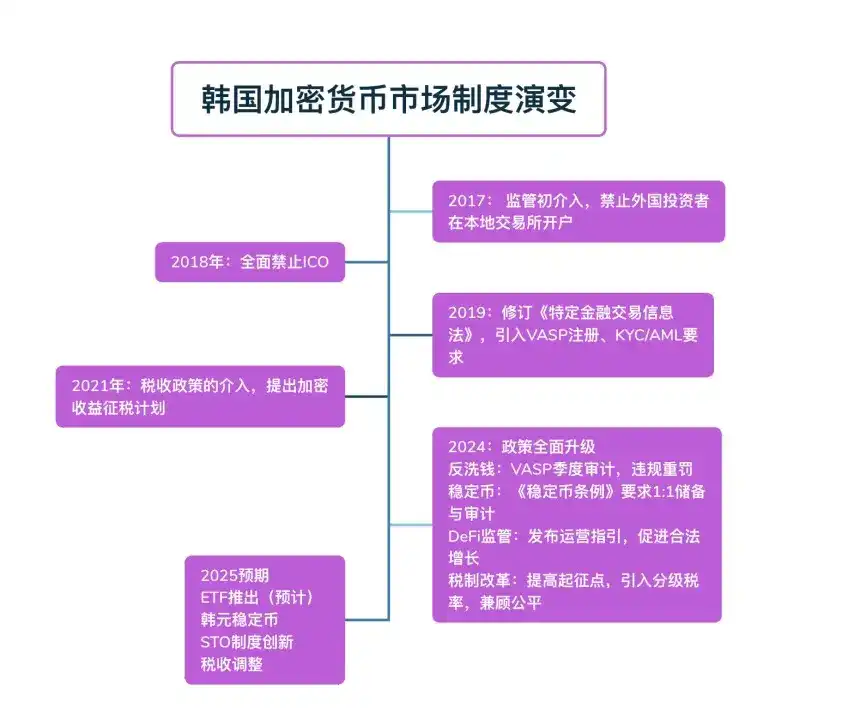
· 2017: The South Korean government first intervened in the cryptocurrency market, prohibiting foreign investors from opening local trading accounts to curb international speculation.
· 2018: A comprehensive ban on ICOs was implemented to prevent fraud and excessive speculation, leading several South Korean blockchain projects to relocate their fundraising to Singapore.
· 2019: The "Specific Financial Transaction Information Act" was amended, requiring virtual asset service providers (VASPs) to register and comply with anti-money laundering (AML) and KYC regulations.
· 2021: Plans began to tax individual cryptocurrency gains, ultimately implemented in 2024 to increase tax revenue.
· 2024:
Strengthening anti-money laundering and stablecoin regulations: New regulations require all VASPs to submit compliance reports and undergo anti-money laundering audits.
Innovation support and blockchain ecosystem development: Establishing a national blockchain innovation center to promote blockchain technology applications.
Regulatory exploration in emerging fields: Issuing "Decentralized Finance Regulatory Guidelines" to strengthen the regulation of DeFi protocols.
Tax policy adjustments: Revising cryptocurrency tax legislation to raise the tax threshold and implement a tiered tax rate mechanism.
Green blockchain initiatives: Promoting carbon neutrality in the cryptocurrency industry and supporting mining operations using renewable energy.
9. Participation of Traditional Companies in South Korea
9.1 Kakao
Kakao has become a core force driving the development of the South Korean crypto industry, deeply involved in trading platform and public chain construction while actively planning future layouts.
· UPbit Trading Platform: Through its subsidiary Dunamu, Kakao launched UPbit in 2017, quickly becoming one of South Korea's largest cryptocurrency trading platforms.
· Kaia: A Layer 1 blockchain platform formed by the merger of Kakao's Klaytn and Japan's LINE's Finschia in 2024, dedicated to building Asia's leading Web3 infrastructure.
9.2 Samsung
As a South Korean tech giant, Samsung is driving comprehensive penetration into the crypto ecosystem with cutting-edge technology, building a complete value chain covering "on-chain and off-chain" from underlying hardware to enterprise platforms and personal devices:
· Blockchain Technology R&D: Its IT company Samsung SDS has established a blockchain department, developing the enterprise-level blockchain platform Nexledger, which features high performance, strong security, and multi-chain compatibility. It supports smart contracts and various consensus mechanisms, widely applied in finance, government, manufacturing, and other fields.
· Cryptocurrency Wallet: Samsung integrated a cryptocurrency wallet into its Galaxy S10 smartphone, supporting various cryptocurrencies such as Bitcoin and Ethereum. This wallet enhances asset management accessibility through private key management technology. Samsung has also collaborated with multiple blockchain projects to promote the application of blockchain technology in mobile devices.
· ASIC Miner Manufacturing: Through its semiconductor division, Samsung produces ASIC miners, providing hardware support for cryptocurrency mining. In 2016, Samsung's semiconductor revenue was approximately $50 billion; by 2017 (the year of the crypto bull market), revenue grew to $65.3 billion, an increase of about 30%, primarily from the production and foundry of Bitcoin-specific ASIC mining chips.
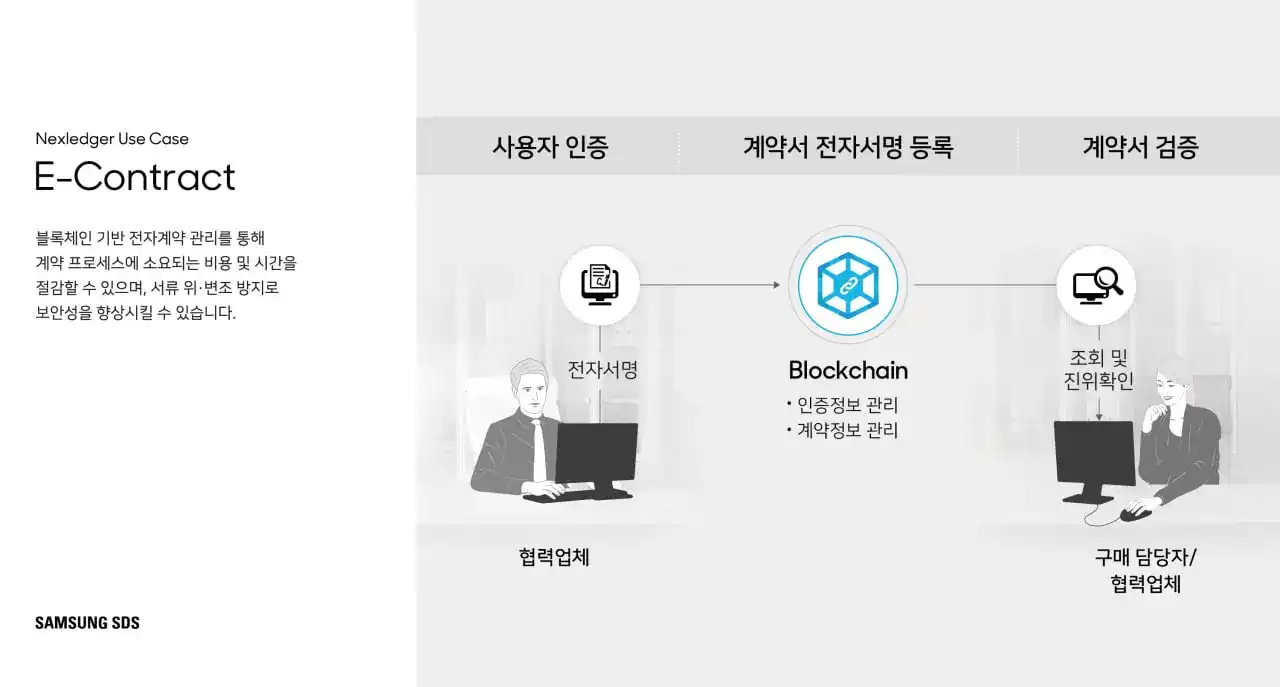
Samsung SDS Blockchain Use Cases (source: Samsung)
9.3 Participation of Other Chaebols
Large South Korean chaebols are actively laying out in the cryptocurrency and blockchain fields:
· SK Group: Through its investment subsidiary SK Square, it plans to issue its own cryptocurrency and has become the second-largest shareholder of the cryptocurrency trading platform Korbit.
· Nexon (NXC): Acquired 65% of the Korbit trading platform, actively laying out in the blockchain and cryptocurrency fields. Its game MapleStory has also issued a token.
· Shinhan Financial Group: Its subsidiary Shinhan Capital is considering investing in Korbit to further expand its business in the blockchain and cryptocurrency sectors.
10. Future Trend Analysis of the South Korean Market
10.1 Investor Confidence and Market Sentiment
The current sentiment in the South Korean market is generally cautious, with significant confidence differentiation. 75% of investors are optimistic about Bitcoin, but at the same time, 46% of respondents express concern or extreme concern, with only 24.7% being optimistic, while the remaining 29.3% hold a neutral stance, reflecting the market's vigilance towards high volatility.
Regarding altcoins, 36.7% of respondents expect to see an "Altcoin Season" in the third quarter of 2025, indicating investors' anticipation of a phase of recovery for non-mainstream assets. Overall, market sentiment shows characteristics of "strong expectations for major coins, partial recovery of altcoins, and increasing emotional differentiation."
10.2 Scalable Growth and User Popularization
· Market Scale Expansion: According to Grand View Research, the South Korean crypto market is projected to have a compound annual growth rate of 16.1% from 2025 to 2030, with revenue expected to grow from $264.3 million in 2024 to $635.4 million by 2030.
· User Base Breakthrough: Industry analysis suggests that by the end of 2025, the market user base may reach 20 million, accounting for nearly 40% of the total population.
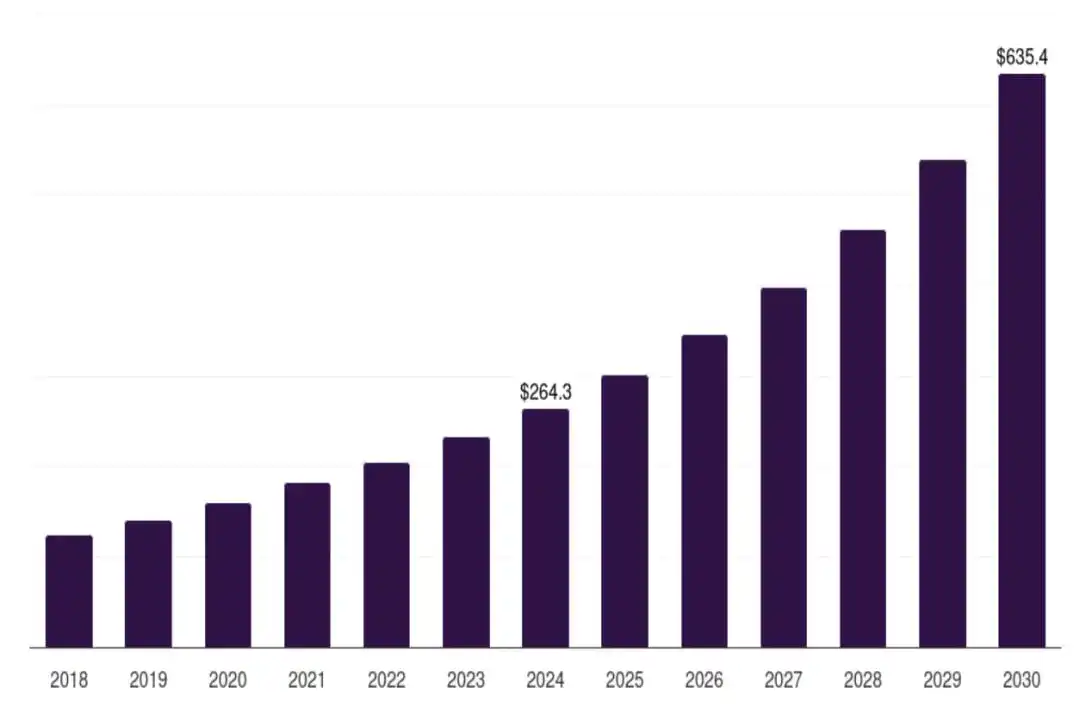
South Korea Crypto Market Forecast 2018-2030 (US$M) (source: Horizon)
10.3 Technological and Ecological Innovation
The South Korean crypto ecosystem is transitioning from foundational chains and trading phases to a diversified and compliant era. Looking ahead, three major tracks are particularly noteworthy:
DeFi and Layer 2 Driven
In the face of "political uncertainty driving the demand for self-custody," along with the depreciation of the Korean won increasing the demand for safe-haven assets, DeFi has become a rational option for capital flight and appreciation. In 2024, global DeFi Total Value Locked (TVL) surged by 211%, reaching $214 billion. Layer-2 solutions are also accommodating an increasing amount of DeFi liquidity due to their high throughput and low-cost characteristics.
Deep Integration of AI and Blockchain
South Korean telecom giants and research institutions have synchronized AI, 5G, and blockchain into their digital transformation paths. SK Telecom's projects integrating AI, 5G, decentralized identity (DID), and NFT/DAO have been piloted in Seoul and Busan, with an expected user penetration rate exceeding 15% by 2025.
RWA Asset Tokenization Track
To hedge against fluctuations in local currency and traditional assets amid escalating trade frictions and geopolitical uncertainties, the global economic environment is becoming increasingly turbulent. The characteristics of the South Korean market also determine that RWA tokenization and the entertainment industry will be the main driving forces behind the expansion of Web3 in South Korea. Meanwhile, stablecoins are also accelerating development, with Lee Jae-myung advocating for "the establishment of a Korean won stablecoin market as soon as possible." Currently, assets such as gold, copyrights, and real estate in South Korea are gradually moving on-chain.
10.4 Product and Institutional Evolution: ETF and Financial Institution Involvement
By 2025, South Korean securities trading platforms have clearly outlined plans to "explore the issuance of cryptocurrency ETFs" to meet the incremental demand from institutional investors and align with global market trends. Shinhan Bank, KB Kookmin Bank, and others have initiated pilot projects for crypto asset custody and cross-border payments, while NH Investment & Securities and Woori Bank are also advancing STO and asset tokenization projects.
11. Cryptocurrency Policy Under the New Presidency
In June 2025, Lee Jae-myung officially took office as the 21st President of South Korea, and his "crypto-friendly" stance quickly transformed into policy execution. Unlike the previous administration's lagging reforms, Lee Jae-myung immediately promoted the "second phase of cryptocurrency asset legislation," accelerating the establishment of a digital asset framework that balances compliance and innovation.
11.1 High-Level Consensus and Policy Mainline
Lee Jae-myung and several major candidates reached a "bipartisan crypto commitment" during the campaign, supporting institutional innovations including spot ETFs, Korean won stablecoins, and STOs. The new government focuses on three major directions:
Launching a tiered licensing system to clarify the boundaries of various crypto businesses; initiating a blockchain special zone plan to accelerate pilot implementation; and promoting legislation for Korean won-pegged stablecoins to strengthen financial sovereignty.
11.2 ETF and Korean Won Stablecoin Dual-Drive
The government has initiated negotiations with trading platforms regarding the trading mechanism for Bitcoin spot ETFs, aiming to attract institutional investors such as pension funds and lower the entry barriers for retail investors. At the same time, regarding the "internationalization of the Korean won," South Korea is promoting stablecoin legislation, encouraging banks and digital asset institutions to jointly issue Korean won stablecoins, and advancing cross-border settlement pilots in conjunction with CBDC infrastructure. This dual-drive strategy aims to hedge against the capital outflow risks of dollar stablecoins and enhance the position of the Korean won in the Asian fintech ecosystem.
11.3 Tax Adjustments and Regulatory Upgrades
The originally planned 20% capital gains tax set to be implemented in 2025 has been postponed to 2027, with the tax exemption threshold raised to 50 million won. The government also plans to impose a comprehensive income tax of 6%-42% on high-frequency traders and is studying an on-chain wallet reporting mechanism, attempting to encourage compliance while curbing "shadow trading." Additionally, a pilot mechanism for STOs has been launched, allowing certain project parties to legally issue security tokens, opening up new avenues for on-chain finance.
11.4 Policy Dividends and Platform Restructuring
The new policies will benefit platforms like Upbit that already have compliance capabilities, potentially further strengthening their market dominance. Small and medium trading platforms that cannot meet technical and risk control requirements face the risk of being eliminated. Overseas platforms like Binance and KuCoin will need to address the traffic limitations brought about by tightening local policies.
The Lee Jae-myung government is using ETFs and stablecoins as leverage to reshape the infrastructure of the South Korean crypto market; through tax reforms and regulatory sandboxes, it is creating institutional space for industry innovation. South Korea is steadily moving towards becoming a strong nation in digital assets with institutional transparency and market inclusivity.
With active local capital, widespread public participation, and relaxed policies, South Korea is rapidly emerging as a key growth pole for global crypto assets. Compared to tightening regulations in Singapore and a slowdown in Hong Kong and Japan, South Korea demonstrates stronger policy execution and market momentum. For project parties, there is not only a highly active user base and clear compliance pathways but also opportunities for rapid scaling through chaebol resources and local social ecosystems.
References
Kaiko: State of the Korean Crypto Market
Financial Services Commission: 2024 H1 Survey Results on Virtual Asset Service Providers
Hankyung: 2025 Altcoin Outlook… Find the "Hidden Gems" with High Potential
Klein Labs: Kaia's Rise: Will LINE & Kakao Propel It Past TON?
Magazine Hankyung: "YOLO" is Going, "YONO" is Coming… Spending According to Pocket Conditions for Generation Z
Side Jobs: S&P 500 ETF vs KOSPI 200 ETF Yield Comparison, How Much Difference in Returns by Investment Period?
With Trump's Return, Domestic Investment Reaches 25.25 Million… The Coin Market is Growing Rapidly [New Coin Era]
This article is from a submission and does not represent the views of BlockBeats.
免责声明:本文章仅代表作者个人观点,不代表本平台的立场和观点。本文章仅供信息分享,不构成对任何人的任何投资建议。用户与作者之间的任何争议,与本平台无关。如网页中刊载的文章或图片涉及侵权,请提供相关的权利证明和身份证明发送邮件到support@aicoin.com,本平台相关工作人员将会进行核查。




